THONIS-HERACLEION AT THE ST. LOUIS ART MUSEUM
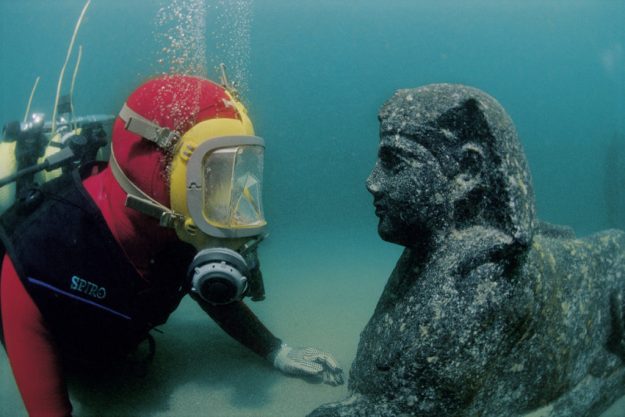
Face-to-face with a sphinx representing Ptolemy XII, father of Cleopatra VII (1st century B.C.). Courtesy of St Louis Museum of Art; Photo: Christoph Gerigk©FranckGoddio/Hilti Foundation

Colossal statue of Hâpy, Heracleion, Aboukir Bay, Egypt, Courtesy St. Louis Museum of Art, Photo: Christoph Gerigk ©Franck Goddio/Hilti Foundation
HISTORY OF THONIS-HERACLEION
Between the 8th century BCE and the founding of Alexandria in the 4th century BCE by Alexander the Great, Thonis – Heracleion (once thought to be two separate cities), on the western branch of the Nile, was Egypt’s main port of entry from the Mediterranean. Then, more than 1,200 years ago, the city, together with its neighbor Canopus, disappeared, swallowed by the sea (like the legendary Atlantis), the victim of earthquakes, rising waters, and other natural disasters. Over the centuries most traces were wiped out, and they were largely forgotten.
Historical texts provided tantalizing hints. Between 60 BCE and 30 BCE, the Greek historian, Diodorus of Sicily, wrote about the city in his “Biblioteca Historica.” Previously, Herodotus wrote about how Heracles, the Greek god and hero, visited Thonis, as a result of which the Greeks added his name to the city making it Thonis-Heracleion. Herodotus also said that Helen of Troy and Paris had stopped here after her abduction.
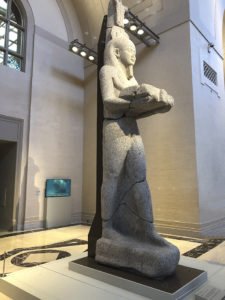
The God of Nile Flooding, Hapy from the lost city of Thonis-Heracleion.
In addition to being a center of trade and commerce, Thonis-Heracleion was a prominent religious site with an enormous temple to the heroic god, Heracles. The annual Mysteries of Osiris (see below) took place here.
HISTORY OF CANOPUS
The ancient city of Canopus sat two miles west of Thonis-Heracleion. A sacred waterway linked the two cities and allowed Canopus to serve as the festive climax to the Mysteries of Osiris. Several ancient texts refer to it. According to legend, Canopus, a 2nd-century sailor who died here after being struck by a viper, gave his name to the city. Canopus was famous during the Ptolemaic period as the site of the sanctuaries of Osiris and Serapis (originally a Greco-Egyptian deity of the sun) that stood here, reputedly the sites of miraculous healing.
As an aside, during Roman times Emperor Hadrian built a replica of a portion of Canopus at Villa Hadriana, outside Rome, to remember the good times he had enjoyed there during his visit to Egypt. (Also in the exhibition is a statue of Antinous, Hadrian’s lover, who drowned in the Nile in 130 CE. The statue was found during excavations of a Roman-era cemetery close to Canopus).
 Osiris Awakening; Thonis Heracleion; Courtesy of St Louis Art Museum; Photo: Christoph Gerigk©FranckGoddio/Hilti Foundation
Osiris Awakening; Thonis Heracleion; Courtesy of St Louis Art Museum; Photo: Christoph Gerigk©FranckGoddio/Hilti Foundation
MYSTERIES OF OSIRIS
In ancient Egyptian mythology, Osiris was the son of the Earth and Sky, destined to succeed them. He brought peace and order to Egypt and introduced agriculture, ensuring its success with the annual flooding of the Nile River. Seth, his brother and the god of chaos, murdered Osiris, chopped him up and scattered his pieces across Egypt. Isis, his wife (who was also his sister), put Osiris’ body back together and then conceived their son, Horus.
Osiris became the Lord of the Afterlife, while Horus conquered Seth and became the ruler of Egypt. The annual reenactment of the murder and rebirth of Osiris was one of the important religious events in ancient Egypt. During the reenactment, figurines of Osiris made of grain, minerals, and silt from the Nile were taken from the temple at Thonis-Heracleion to Canopus, the sanctuary of Osiris.
DISCOVERY OF THONIS-HERACLION
In the late 20th century the European Institute for Underwater Archaeology (IEASM (the French acronym)), under the direction of the maritime archaeologist, Franck Goddio, together with the Egyptian Ministry of State for Antiquities, began exploring the area off the coast of Alexandria. Formerly a banker, Goddio gave up his career to follow his passion for underwater archeology. It was a colossal face staring out at him from the shadows that led Goddio and his team to uncover the two lost cities of Thonis-Heracleion and nearby Canopus, 30 feet under the surface of the Mediterranean Sea.
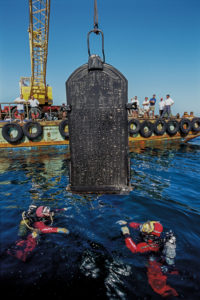
The retrieval of the granite Stele of Thonis-Heracleion. Courtesy of STL Art Museum; Photo Christoph Gerigk©FranckGoddio/Hilti Foundations
In addition to buildings, temples, and statues, Gobbio found 13 limestone animal sarcophagi, goblets, figurines, amulets, coins and many other objects. Once they were photographed in situ and cataloged, they were carefully winched up onto Goddio’s research boat, the ‘Princess Duda.’
After exhibitions at the British Museum and the Institut du Monde Arabe in Paris, 283 of the objects can now be seen at the St. Louis Art Museum. However, this is not everything. Goddio estimates that about 95 percent of the site remains to be excavated. For the moment, we must be content with these tantalizing relics.
EXHIBITION
While entire books have now been written on the contents of this exhibition, we will only describe a few, hoping to entice you to visit and see for yourselves, either in St. Louis or at the Minneapolis Institute of Art, where the exhibition will be starting on 9 November 2018.
As you enter the Sculpture Hall of the St. Louis Art Museum, three enormous granite statues greet you. Each is between 16 and 18 feet in height and weighs as much as 12,000 pounds. The red granite statue is Hapy, god of the annual flooding of the Nile; the other two are a Ptolemaic-era Pharaoh and a queen. The three sculptures once stood at the entrance of the temple to the heroic god Heracles at Thonis-Heracleion.
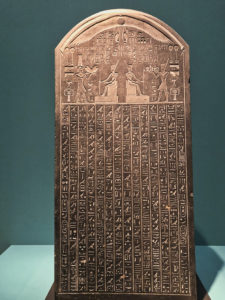
The Stele of Thonis-Heracleion, St. Louis Art Museum
Inside the exhibition hall, look for the Stele of Thonis-Heracleion outlining the Decree of Nectanebo I of the 30th dynasty of ancient Egypt (380-362 BCE). Found lying facedown on the seabed, it is one of a pair that outlined payments to the local temple. According to the hieroglyphics, the priests in charge of the temples of the goddess Neith received ten percent of the waterway-use tax. The scene at the top of the stele shows Nectanebo I presenting offerings to the goddess Neith. On the left, he is depicted wearing the white crown of southern Egypt, and at the right, the red crown of northern Egypt. Two rearing cobras on a winged solar disc hover above the two.
Nearby is a slab engraved with a ram head depicting the god Amun, the patron god of Thonis-Heracleion. The precise function of this particular object is still unclear but is probably linked to some ritual.
The Awakening of Osiris (664-525 BCE) portrays Osiris, newly awakened after his death. He is lying on his stomach, covered with a sheaf; he lifts his head and smiles. In addition to his beard (a symbol of divine kingship), Osiris wears a crown with ostrich feathers and twisted ram’s horns. A sun disc, the symbol of the reborn Osiris also decorates the crown.

The goddess Tawaret, portrayed as a hippo; St. Louis Museum of Art
A hippopotamus standing on its hind legs portrays the goddess, Tawaret. Female hippos symbolized maternity and fertility. In the Osiris myth, Tawaret protects Isis and her baby, Horus, from Seth. Magic knots (a symbol of protection) support the hippo on each side.
These are just some of the treasures shown at the exhibit of Egypt’s Sunken Cities. They range from colossal statues to the smallest objects, a testament to the knowledge and technology used to excavate the site.
Thonis-Heracleion is but one place that has given up its treasures from the depths of the waters. Who knows how many other places like this exist around the world, just waiting for Franck Goddio or someone else to discover them?
IF YOU GO
St. Louis Art Museum is located inside Forest Park at 1 Fine Arts Drive, St. Louis, MO; open Tuesday to Sunday 1000 to 1700; Friday 1000 to 2100; closed Monday. The Exhibit of Sunken Cities of Egypt will be open until 8 September 2018.
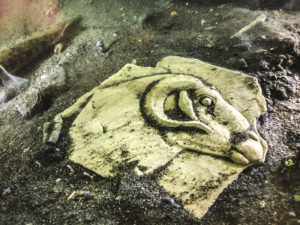
The Ram head depicting Amun, patron god of Thonis-Heracleion, St. Louis Museum of Art
Minneapolis Institute of Art is located at 2400 Third Ave. South, Minneapolis, MN. It is open Tuesday, Wednesday, and Saturday from 1000 to 1700; Thursday and Friday 1000 to 2100, Sunday 1100 to 1700; the exhibition of Sunken Cities of Egypt will run from 4 November 2018 to 14 April 2019.
Copyright secured by Digiprove © 2018 Diana Russler